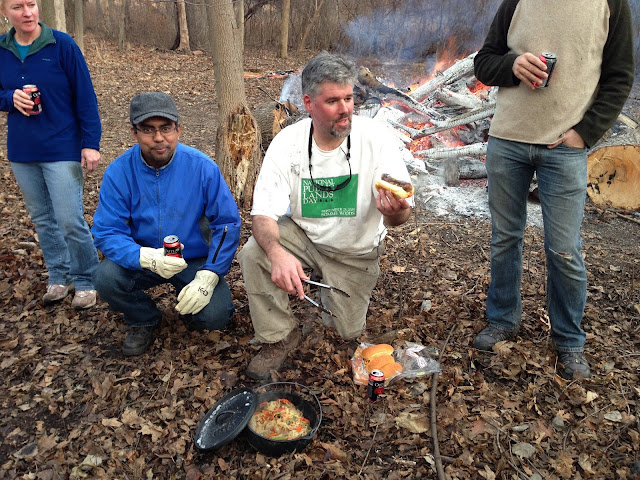It's a time of flowers, seeds - and falling back in grass and looking at the sky.
Then we brandish saws to slay the brush and transform it into bonfires
that sometimes cook our food.
It's a rich, easy, splendid time to be in nature.
 |
| Few bugs, little heat and humidity, deep colors, the threat of impending winter. Hurry! Come out and join us! We love fall for all these reasons. And there are better reasons too. |
 |
| Some of our most beautiful flowers bloom in early fall. We're enriched by them. But we are drawn to seeds. We need plant embryos to restore health to more nature. |
 |
| Plums and grapes once attracted the eyes of foxes, bears, and people. They still attract our eyes. Not enough animals these days move plum pits where they're needed. So we do. And plums multiply. |
 |
| A handful of woodland puccoon seeds means "instant rare plant - restored" to an area that needs it. Our lives deserve more that makes us feel this good. |
 |
| A prairie dock leaf frames stems of Indian grass, smooth blue aster, and purple prairie clover bearing seeds. We take in all - as we reach for the seeds. |
 |
| As we harvest, we connect with pasts - from hunter-gatherers to pioneer farmers. We feel by turns empowered, meditative, companionable, and alone in deep nature. |
 |
| Then comes seed prep. To ready these treasures for planting, with care and anticipation. The seeds delight our eyes and fingers; they're time capsules for next year's life. |
 |
| The onset of brush bashing is also a time of celebration. Buckthorn is an enemy easily understood - and readily defeated by mighty stewards. |
 |
| The threat is obvious here. Bright fall colors mark the oaks, elms, and hickories. Buckthorn stays green and usurps the entire understory so little else can grow. A bully, it must go. |
 |
| We celebrate work with food. Life is good. In many senses. |
 |
| All of us prepare for winter in our own ways. |
 |
| This garter snake will now go underground to an "hibernaculum" with others of its kind. |
 |
| Modern seeds prepare for winter by inspiring us to transport them to future habitats. Then they'll lie in wet ground going through age-old changes, waiting for the light and warmth of a new year. |
 |
| In fall, much rots. Decomposition and renewal sweep away the past, providing opportunities for the future. |
 |
| In late November and early December come the fires. They are another form of decomposition and renewal. We need and rejoice in them too. |
From September through December, we rejoice in our prairies and woodlands. The Somme team's fall schedule is at www.sommepreserve.org. Or find a group near you in your local park or preserve.
Photo credits
Well, gosh, I don't even know who took them all. The splendid fringed gentian was almost certainly taken by the great Lisa Culp Musgrave. Most of the others are probably mine, although I notice that I'm in at least one, so I didn't take that. If you see a photo of yours here, please tell me so I can give you credit.
Most of these photos are from Somme. The grass-sprawled boys as well as the line of seeders are from the Orland Grassland. The fat garter snake is from Deer Grove East.
Most of these photos are from Somme. The grass-sprawled boys as well as the line of seeders are from the Orland Grassland. The fat garter snake is from Deer Grove East.


7 comments:
Beautifully done. Have you considered fashioning this into a children's book or some kind of calendar/almanac?
@Deborah Antlitz: Thanks for good words and ideas. A children's book is needed. An adult's book is too. In fact we should have many. (My photos are "highly available" to anyone willing to use them for something like that.) I'll keep trying.
Your prose awes me. So much to learn about our precious remnants. We were out today collecting seed too.
Gorgeous photos and inspiring comments. Love the photo with the boys. BTW I have two small plum trees growing from some plums that you gave me to eat, I think it was 2 years ago. I'm hoping they transplant well. Thank you!
Nature by definition is not made by people. I wonder if our landscapes really ever were “nature” from the standpoint that human manipulation did not occur. Are our savanna ecosystems really the last surviving pieces of oak, hickory, and hazelnut orchards that fed the great empire which preceded our civilization?
http://www.npr.org/sections/thesalt/2014/10/24/358527018/nutritious-acorns-dont-have-to-just-be-snacks-for-squirrels
I second all the above. The dock close-up is wonderful. The purple gentian is stunning. The idea of creating a sampler book of the great photos is a good one, for sure. Congrats to Steve for his recognition at the upcoming event this month.
Well-deserved, as we all can agree.
Post a Comment